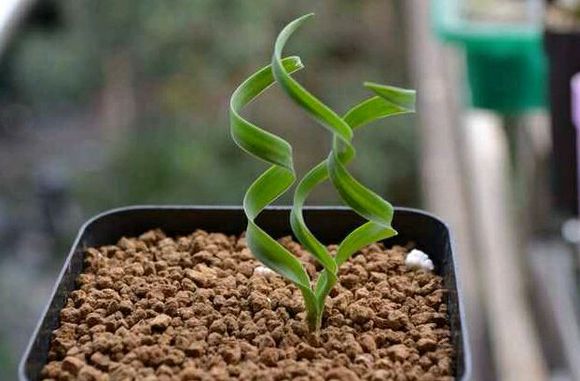Spring feather culture method
1. Soil
Chunyu does not have high requirements for soil, slightly acidic breathable and drained soil can be used, the simplest one is made of rotten leaf soil or humus soil, peat soil or garden soil mixed with river sand, and can also be connected with base fertilizer before planting, because Chunyu likes fertile soil.

2. Watering
The principle of spring feather watering is to keep the soil moist in all seasons except winter. In summer, because the temperature is too high, it is necessary to spray water on the leaves to cool down, pay attention to drainage in the rainy season, and there is no stagnant water in the roots. to prevent plant roots from rotting.
3. Fertilization
Chunyu does not have very high requirements for fertilizer, put base fertilizer on the pot, and then apply fertilizer once a month. Fertilization is generally based on thin liquid fertilizer, and rotten thin cake fertilizer is very good; in winter, because the temperature is too low, the plant will stop growing, and then stop fertilizing the plant.
4. Temperature and light
The most suitable temperature for the growth of spring feather is between 18 ℃ and 25 ℃. Because the temperature is too high in summer, it is necessary to spray water to cool the plant. In winter, the temperature is too low, so the plant should be put indoors for heat preservation. In addition, Chunyu likes shade, does not like light, usually put in the position of astigmatism on the line, summer should not be direct light, because the winter light is relatively soft, can be placed in the sun, but the temperature is not lower than 8 ℃.
The above is the introduction of how to raise spring feathers. Let's take a look at what we need to pay attention to in the process of breeding spring feathers.
How to raise Spring Feather Culture methods and matters needing attention
Most of the names of plants are based on their shape and appearance. Chunyu is a green plant that looks like a feather. Usually planted in some public places, because the spring feather is a relatively large plant, so usually the space where the spring feather is located needs to be larger.
How to raise Chunyu
Chunyu likes the high temperature and humid growth environment, does not have high requirements for light, and has a strong ability to withstand shade. Spring feather is not cold-resistant, the suitable temperature for growth is between 18 ℃ and 25 ℃, and the overwintering temperature in winter is not lower than 5 ℃. Chunyu likes sandy soil that is loose, fertile and well drained.
Methods of spring feather culture and matters needing attention
1. Soil
As far as the habit of spring feather is concerned, spring feather likes slightly acidic soil with fertile, loose and good drainage, so it has lower requirements for soil. Family cultivation of spring feather can be made by mixing a small amount of river sand, such as rotten leaf soil, peat soil and garden.
2. Watering
Spring feather likes a wetter environment and requires more water, but the requirement for water is not high, so you can pour Amoy rice water at ordinary times. Pay attention to keeping the soil moist during the growing period. It should be noted that the amount of water needs to change according to the season. In summer, spray water on and around the leaves to maintain a moist environment; in winter, you should reduce the frequency of watering.
3. Fertilization
Spring feather has strong adaptability, no matter wet environment or dry condition, it can adapt as soon as possible. Therefore, the demand for fertilizer is not high, put some hoof slices or deep fry on the bottom of the basin, and then only apply liquid fertilizer, such as thin pancakes, once a month. Special attention should be paid to little or no fertilization in winter to meet the needs of plants.
4. Light temperature
Spring feather likes temperature and shade, but is not cold-resistant and afraid of light, and avoids strong light irradiation. The suitable temperature is 18 °- 25 °. Therefore, it is necessary to move the spring feather to a shady place in summer to avoid direct sunlight. In winter, it can be moved to a place with sufficient light to make the overwintering temperature as high as 8 °. 5. Diseases and insect pests
The common diseases of spring feather include leaf spot and anthracnose, which can be controlled by carbendazim, methyl topiramate and so on. If there are some problems such as yellow and withered leaves, they need to be trimmed. The common pests of spring feathers include red spiders and shell insects, which can be controlled by special pesticides. In addition, more ventilation is needed to prevent insect pests.
6. Reproduction
The temperature should be kept at a fixed value of about 20 °to avoid overheated or cold air environment; humidity should be kept high, and more water should be sprayed and sprinkled to increase the moderation of the environment; light and temperature should be kept at a normal value to avoid being too high or too low; the principle of fertilization is "frequent application of thin fertilizer" and mainly nitrogen fertilizer; high watering frequency should ensure that it is moist at all times in summer and dry and wet alternately in winter.
How does Chunyu spend the winter?
1. Control of room temperature
If you want insurance, octave and above can safely survive the winter, the minimum had better not be less than zero degrees Celsius. Although plants may be able to bear it and slowly come back to life the following spring, let's not make fun of our beloved plants.
2. Moisture control
We may have all heard that the origin of Chunyu is in a hot and humid place, so there is a great demand for water. Although dormancy begins in winter and the amount of water needed is reduced accordingly, we should not forget to water it. Water in time when the basin soil becomes dry and cracked, but do not soak in water. In addition, it can be taken care of by sprinkling water on the leaves and spraying water into the surrounding environment.
3. Control of lighting.
If you put it in a dark place for a long time, its leaves may slowly turn yellow and the beautiful green will gradually disappear. So let it see the light on a regular basis. However, it doesn't like long-term light either. Yes, it's a little harsh. So choose a semi-shaded environment, or bask in the sun for a while and then take it back in time.
4. Fertilizer control
Pay attention to the dosage from the end of autumn, winter will enter the dormant period, almost no nutrients, so fertilizer should be suspended.
The solution to the decay of spring feather leaves
If it has already rotted, if it is not serious, it can be pruned according to it. If there is too much water or improper fertilization, it needs to be replanted by changing the soil.
Be sure to choose soil that is both permeable and breathable before planting plants, so that even if you water too much occasionally, it will be easy to drain out.
Don't pour it in at once during daily watering, you can pour it slowly, and you can grasp the amount of water when watering to see how much water you put in, and the drain hole below will come out, and then make a record, so that you can compare the watering in the future. When the temperature drops to 15 degrees, watering must be controlled, when the plant's demand for water gradually weakens.
When fertilizing at ordinary times, we must pay attention to the concentration of fertilizer, dilute the thicker fertilizer, and slowly apply it along the edge of the basin.
Try to choose a place with good ventilation for maintenance.
It is important for cultured plants to create an appropriate growth environment according to the normal growth needs of plants, and to pay attention to some important growth links of plants, such as flowering, reproduction, wintering and summer, and often pay attention to the growth status of plants to deal with corresponding diseases and insect pests and special symptoms.
Methods of aquaculture of spring feathers
Spring feather alias: spring taro, feather split forest taro, Camptotheca acuminata, cherry angel vine green velvet, for perennial evergreen herbs. It is more resistant to shade. So what is the method of hydroponic spring feather culture? Let's have a look!
I. the culture method of hydroponic spring feather
1. Remove the soil from the root
The hydroponic female parent had better be a well-growing, healthy and harmless plant, and then after loosening the potted soil, gently take out the spring feather seedlings, shake off all the soil from the roots, rinse the whole plant with water, remove the rotten leaves, and do not bring any soil, otherwise it may cause the rotting roots of spring feathers because of bacteria or water pollution.
2. Prune the root system
After rinsing the plant, cut its old root by 2 beat 3-3 beat 4, and those weak roots, old roots and dead roots were also cut off, leaving only new roots.
3. Sterilization and disinfection
After the roots are trimmed, they need to be disinfected. The roots of Chunyu can be immersed in 3% to 5% methyl topiramate solution for about 10 minutes.
4. Induction of aquatic roots
The spring feather plant is fixed in the planting basket with Yuhua stone, or fixed with perlite, vermiculite and so on. In this process, the root should be evenly pierced into the bottom hole of the planting basket, and the root system is also required to stretch, and then it can be put into the induction pool to grow, but if we do not have such conditions, we can also make a domestication box. Choose a plastic bucket, which is about the same size as the planting basket, then put the planting basket in it and add water until it reaches the bottom of the planting basket. After that, it can be put into the shade shed for rooting induction. Remember to check the water level in the box frequently and spray water frequently. New roots will take place in about 10-20 days, and the induction will be considered successful.
2. Management of spring feather hydroponics
1. Temperature and light
Chunyu likes a warm environment, so it is best to keep it at 18-30 ℃ and above 5 ℃ in winter. Chunyu likes sunshine and is very shady, but do not have direct sunlight in summer and pay attention to ventilation.
2. Nutrient solution
Change the water once a week and add the nutrient solution proportionally at the same time, you can also use it to spray the foliage.
Spring feather is growing very fast, and you may need to change the planting basket and vase after a year. This is the end of the introduction of hydroponics. I hope you can succeed in hydroponics.
- Prev

The leaves of lilies turn yellow
Water yellowing is due to the yellowing caused by watering too frequently, mainly for the yellowing of young leaves, while there is no obvious change in old leaves; as long as the moisture is controlled in time. Dry yellow is just the opposite of water yellow, which is caused by too little watering and lack of water, in which case the old leaves will turn yellow from the bottom up.
- Next

The Propagation method of Spring Grass
Sowing and propagation of spring grass has a higher survival rate when sowing and propagation, so it is also widely used. We usually choose to breed in autumn, select full seeds, bury them in loose and fertile sandy soil, then cover them with glass and water them to keep the soil and air moist, so as to increase the emergence rate.
Related
- Fuxing push coffee new agricultural production and marketing class: lack of small-scale processing plants
- Jujube rice field leisure farm deep ploughing Yilan for five years to create a space for organic food and play
- Nongyu Farm-A trial of organic papaya for brave women with advanced technology
- Four points for attention in the prevention and control of diseases and insect pests of edible fungi
- How to add nutrient solution to Edible Fungi
- Is there any good way to control edible fungus mites?
- Open Inoculation Technology of Edible Fungi
- Is there any clever way to use fertilizer for edible fungus in winter?
- What agents are used to kill the pathogens of edible fungi in the mushroom shed?
- Rapid drying of Edible Fungi

